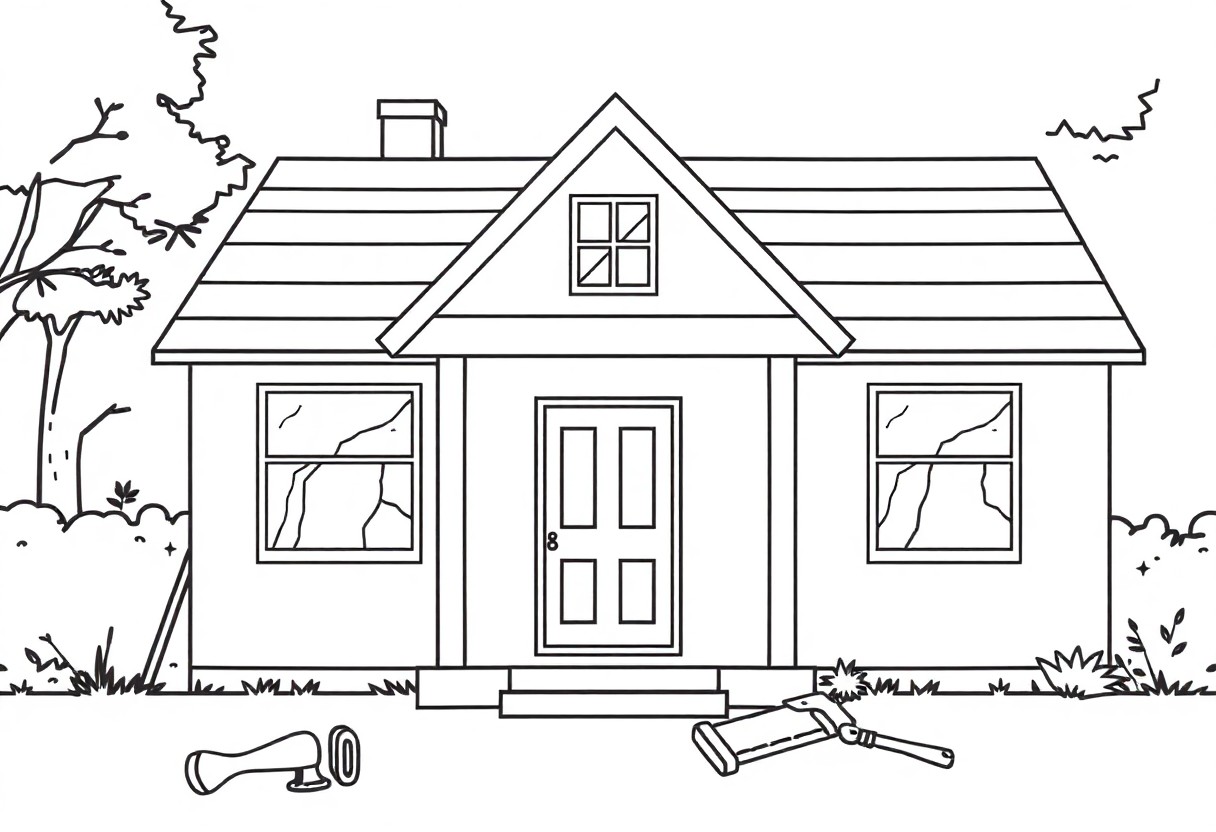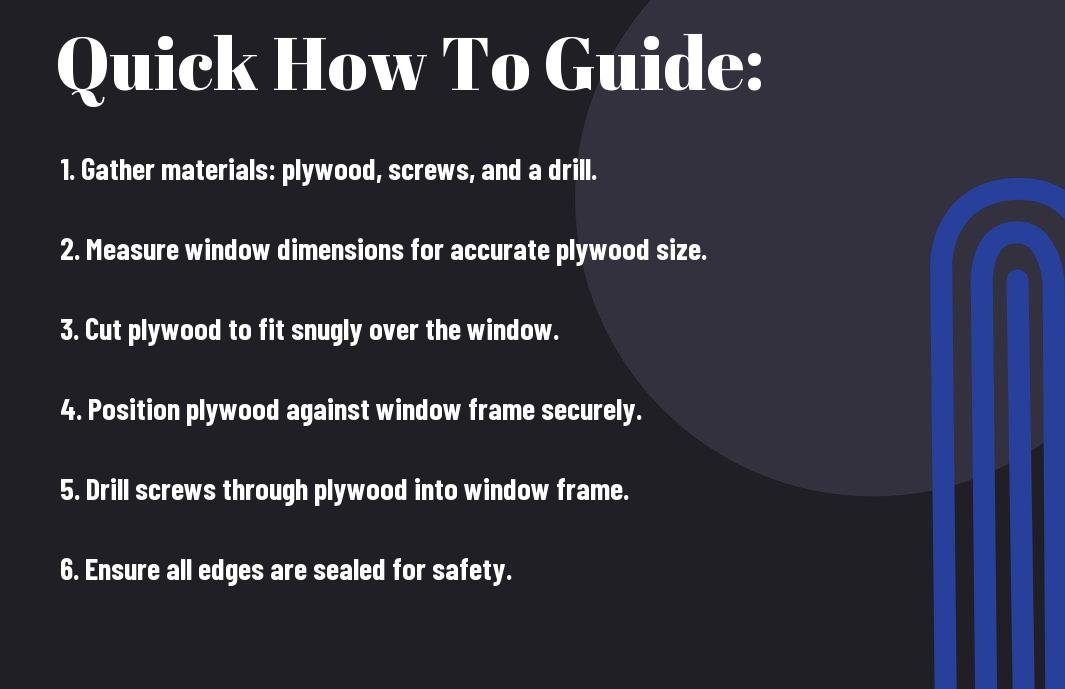Windows can become vulnerable due to severe weather, accidents, or vandalism, making it vital that you act swiftly to protect your home. In this guide, you will learn how to effectively and safely board up your windows to prevent further damage while waiting for repairs. By following these steps, you can ensure the safety of your property and loved ones during this critical time. A good Reddit post with additional guidance checkout: Advice needed on boarding up broken window please.
Key Takeaways:
- Preparation: Gather all necessary materials and tools such as plywood, screws, and a drill before starting the boarding process.
- Measurement: Accurately measure the window dimensions to ensure the plywood fits securely against the frame.
- Installation: Securely attach the plywood using screws, ensuring there are no gaps to prevent further damage or intrusions.
Understanding the Need for Boarding Up
Before a broken window exposes your home to the elements and potential intruders, it’s necessary to board it up effectively. This not only protects your property but also maintains safety during the repair process. For a comprehensive guide, check out How to Board up a Window Right Now in 7 Quick Steps to ensure the job is done right.
Safety Considerations
Even while boarding up your windows, prioritize your safety. Make sure to wear protective gear, such as gloves and goggles, to shield yourself from splinters, sharp edges, and debris. Ensure your ladder is stable if you need to reach higher panes and keep your workspace clear of hazards.
Reasons for Broken Windows
Reasons for broken windows often vary, ranging from accidental impacts to deliberate vandalism. Weather events can also play a significant role, with strong storms or hail damaging glass surfaces. Understanding these causes can help you take appropriate preventive measures in the future.
Considerations for preventing broken windows include securing your property with weatherproof materials and addressing any potential hazards, such as nearby branches or debris. When a window breaks, act quickly to assess the damage and avoid further risks, such as exposure to weather or unwanted access to your home. Being proactive not only preserves your home but also enhances your security.

Essential Tools and Materials
Any effective window boarding project requires a specific set of tools and materials. Having the right equipment not only streamlines the process but also ensures your safety and the integrity of your home. Investing in reliable tools will provide you with peace of mind during repairs and help mitigate future damage.
Tools Needed for Boarding Up
If you’re preparing to board up your windows, you’ll need a few imperative tools. A circular saw or hand saw, a drill, and screwdriver are fundamental for cutting and securing your boards. Additionally, measuring tape and a level will ensure a precise fit.
Materials to Use
Assuming you have your tools ready, you will need sturdy materials to secure your windows effectively. Use plywood that is at least 1/2 inch thick for strength and durability. Fasteners such as screws or nails will be necessary to attach your plywood securely, while hurricane ties can provide extra stability in severe weather conditions.
Tools and materials work hand-in-hand to ensure a strong defense for your windows. Choose weather-resistant plywood to combat moisture and limit wood rot. Coating your plywood with a paint or sealant will further enhance its lifespan. Using high-quality screws will withstand pressure and provide an added level of security, so you can feel at ease during your window repair process.
Step-by-Step Guide to Boarding Up Windows
All steps outlined in this guide will help you effectively secure your windows while awaiting repairs. Following the instructions below will ensure a safe and efficient boarding process.
| Step | Description |
|---|---|
| 1 | Preparing the Area |
| 2 | Measuring and Cutting the Board |
| 3 | Attaching the Board |
Preparing the Area
Any debris or objects near the window should be cleared away to create a safe working space. Ensure the area is well-lit and free of hazards, as this will help you work more efficiently and prevent accidents.
Measuring and Cutting the Board
Clearly, taking accurate measurements of your window is crucial for a proper fit. Measure the height and width of the window opening, allowing a few extra inches for secure positioning of the board.
Cutting the board to the right dimensions is important for both functionality and aesthetics. Use a circular saw or a hand saw and take your time to ensure clean, straight cuts. Make sure to wear protective gloves and goggles, as there might be sharp edges. If the board does not fit snugly, it may not provide adequate protection. A well-fitted board ensures stability and reduces the risk of it being blown away or compromised by strong winds. The right measurements and cuts keep your home safe while the repairs are being performed.
Tips for Effective Boarding
Now, to ensure your window boarding is as effective as possible, keep these tips in mind:
- Choose high-quality material for boards.
- Make sure your measurements are accurate.
- Use enough fasteners for added strength.
- Check the weather before proceeding.
Perceiving these vital steps can significantly enhance the outcome of your window repair project.
Choosing the Right Fasteners
With fasteners, it’s important to select options that provide optimal strength and stability. Opt for heavy-duty screws or bolts to secure the boards tightly against your windows. If you anticipate severe weather or a potential break-in, using lag bolts can offer additional reassurance.
Securing the Board Properly
For proper securing, ensure that each board is fixed tightly against the window frame. This requires aligning the board evenly and using multiple fasteners to anchor it securely. Additionally, consider using washered screws or anchors for improved grip.
Right fasteners can make a significant difference in the overall stability of your boarding. Aim for high-traction materials that resist pulling out under pressure, and make sure to position them at regular intervals for even distribution. A properly secured board not only provides safety but also maintains the integrity of your home, even during unfavorable weather conditions. Enhancing stability with the right measures keeps your surroundings safeguarded while waiting for repair work to commence.
Factors to Consider Before Boarding Up
Many aspects are crucial when deciding to board up your windows for a broken window repair. Consider the following factors:
- Overall window type
- Estimated repair duration
- Your home’s security needs
- Local weather conditions
This information will help you make informed decisions for effective boarding.
Type of Window
On considering the type of window you have is imperative. Different window styles, such as single-pane or double-pane, will require varying methods of boarding up. The materials used, along with the level of damage, will dictate which boarding technique is most suitable to provide stability and protection.
Duration of Coverage
Little thought must go into how long you expect to need the boarding in place. Understanding this duration is important for selecting appropriate materials and methods to ensure durability. The longer you anticipate the need for coverage, the more robust and weather-resistant your chosen materials should be.
Coverage for a broken window repair can vary considerably based on the extent of the damage. If a quick fix is needed, lighter boards may suffice for a short-term solution. However, if the repair will take days or even weeks, it’s vital to use sturdy, high-quality materials that can withstand harsh weather and potential security threats. A lack of attention to these details could lead to increased risks of further damage or vandalism.
Alternative Solutions
To address a broken window effectively, consider alternative solutions that may better suit your situation. Besides traditional boarding methods, you can explore options such as window film, plywood cuts, or even cardboard, depending on the urgency and your budget. These solutions can provide temporary barriers against weather, security threats, and potential injury while you arrange for a more permanent repair.
Temporary Fixes
Assuming your broken window needs immediate attention, temporary fixes serve as a quick way to safeguard your space. Utilize materials like plastic sheeting, duct tape, or cardboard to cover the opening until a more thorough repair can be executed. This method allows you to maintain a level of protection while ensuring safety from elements and intruders.
Professional Repair Options
Professional window repair options offer an excellent solution for your broken window.
Plus, hiring experts ensures a proper assessment of damage, leading to an effective long-term solution. They can provide high-quality materials and expert installation, significantly improving your window’s energy efficiency and security. Engaging professional services not only saves you time but also guarantees compliance with relevant building codes and reduces the risk of further issues in the future. Overall, professional repairs are a worthwhile investment that enhances the safety and aesthetics of your property.

Summing up
Hence, boarding up your windows effectively serves to protect your home while you arrange for broken window repair. By securely measuring and cutting plywood, using quality fasteners, and ensuring proper coverage, you minimize the risk of further damage and provide a barrier against potential intrusions. Following these steps not only safeguards your property but also gives you peace of mind until repairs can be completed, allowing you to focus on restoring your home efficiently.
FAQ
Q: What materials do I need to board up a broken window?
A: To properly board up a broken window, you will need plywood sheets that are at least ¾ inch thick, a saw for cutting the plywood to size, measuring tape to ensure accurate dimensions, a drill or screwdriver for securing the boards, and screws or nails. It may also be helpful to have a level to ensure the boards are straight and additional protective gear such as gloves and eye protection while handling materials.
Q: How do I measure the window frame for boarding up?
A: To measure the window frame, first, use a measuring tape to determine the height and width of the window opening. Measure from the top to the bottom of the frame for the height and from one side to the other for the width. It’s important to take measurements at multiple points to ensure accuracy, as window frames may not always be perfectly square. Once you have these measurements, you can cut your plywood to fit snugly against the window frame, allowing for some overhang on each side for added coverage.
Q: What is the best method for fastening the plywood over the window?
A: To fasten the plywood securely over the window, align the cut plywood sheet over the opening. Use screws or nails to attach the plywood to the window frame. If using screws, it’s best to space them approximately 12 inches apart along the edges of the plywood for stability. Pre-drilling holes can help prevent the wood from splitting. If the window frame is not sturdy, consider using brackets to provide additional support. Ensure that the plywood is tightly fastened to withstand wind and other external forces.

